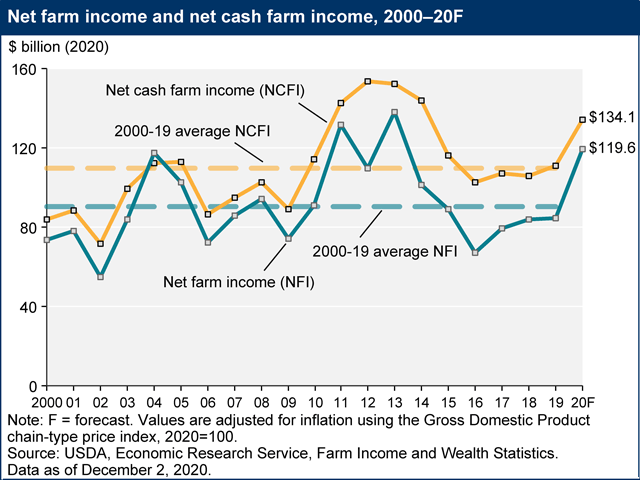Farm Income Higher in 2020
Led Mainly by Ad-Hoc Payments, Net Farm Income Forecast to Reach Highest Level Since 2013
OMAHA (DTN) -- Net cash farm income for 2020 is expected to increase 43.1% from 2019 totals, driven heavily by higher government payments, putting net farm income at the highest level since 2013 once adjusted for inflation.
USDA's Economic Research Service on Wednesday updated farm-sector income and expenses, showing stronger overall profit measures for farmers despite declines in cash receipts for livestock producers.
Net farm income, a broad measure of profits, is forecast to rise $36 billion in 2020 to $119.6 billion, reflecting the fourth straight year of higher net farm income for producers. Ad-hoc government payments led by the Coronavirus Food Assistance Program (CFAP 1 and 2) put direct government payments at $46.5 billion, which is $24 billion higher than 2019.
Under the ad-hoc payments, USDA forecasts CFAP 1 and CFAP 2 payments, combined with aid from the SBA Paycheck Protection Program, would account for $32.4 billion in overall farm income in 2020. As of Monday, USDA reported farmers have collected $21.6 billion in aid under CFAP 1 and CFAP 2. Dec. 11 is the deadline to apply for CFAP 2 payments. USDA also noted roughly $3.7 billion in Market Facilitation Program (MFP) payments authorized in 2019 spilled over into 2020 as well.
"Without the ad-hoc payments, certainly income at the median would be lower," said Carrie Litkowski, an economist with USDA's Economic Research Service
The higher government payments offset a $9.7 billion decline, or 5.5% lower cash receipts, for livestock producers, especially lower sales for broilers, cattle and hogs, though turkeys and chicken eggs saw higher sales. Broilers saw sales fall $6.7 billion for the year, or 23.7%, while cattle and calve receipts fell $4 billion, or about 6%. Hog cash receipts also fell $1.1 billion, or 5.1%.
P[L1] D[0x0] M[300x250] OOP[F] ADUNIT[] T[]
Crop cash receipts are forecast to increase $6.5 billion, or 3.3% higher than 2019, hitting $200.2 billion. Higher crop sales were led by larger income for fruits, nuts and soybeans, though crops such as corn and cotton saw lower returns.
Breaking down individual crops, soybean sales in 2020 are expected to increase $2.6 billion while corn receipts fall by $2.5 billion. Cotton sales also drop $600 million for the year, and wheat sales decline $100 million. Yet, cash receipts for fruits and nuts rose $4.6 billion, potato sales rose $500 million and sugar beet sales grew $900 million.
The average net cash income for farm businesses rose by 33%. Farm businesses are defined as operations with gross cash farm income of more than $350,000, as well as smaller operations where the farm is the primary driver for income.
Median farm household income is forecast to increase $3,881 in 2020 to $86,992, which equates to a 3.4% increase once adjusted for inflation. Still, most farm households rely heavily on off-farm income, which is down 1.6% in 2020, or about $800, to $67,950.
Total production expenses also declined in 2020 by $5.2 billion, or 1.5%, to $343.6 billion. Lower interest rates, along with lower livestock purchases and lower fuel expenses all combined to pull down expenses overall. On the high side of the ledger, farm expenses also showed a 7.6% increase in net rent, or a $1.3 billion rise, to put total rent at $18.1 billion. Taxes and other fees also increased $1 billion, or 7.1%, to hit $15.1 billion. Fertilizer prices also rose 5.1%, or $1.1 billion, to $23.5 billion.
Farmers have more working capital in their operations in 2020. Working capital on farms, which measures the amount of cash available to fund expenses after debt due, is forecast to increase 6% for the year.
Farm assets are projected to show a 1.5% increase -- $45.5 billion -- putting farm assets at $3.12 trillion. That comes from higher real-estate values and other financial investments held by the farm sector. After adjusting for inflation, farm assets and equity are relatively unchanged from 2019.
Still, farm debt is expected to increase 4% this year, or about $16.6 billion, to $435.2 billion, led mainly by a 6.1% increase in real-estate debt for farmers.
The farm sector's debt-to-asset ratio also continues creeping upward to 13.95% for 2020, up from 13.61% in 2019.
More details on USDA's Farm Income Forecast can be viewed at: https://www.ers.usda.gov/….
Chris Clayton can be reached at Chris.Clayton@dtn.com
Follow him on Twitter @ChrisClaytonDTN
(c) Copyright 2020 DTN, LLC. All rights reserved.




